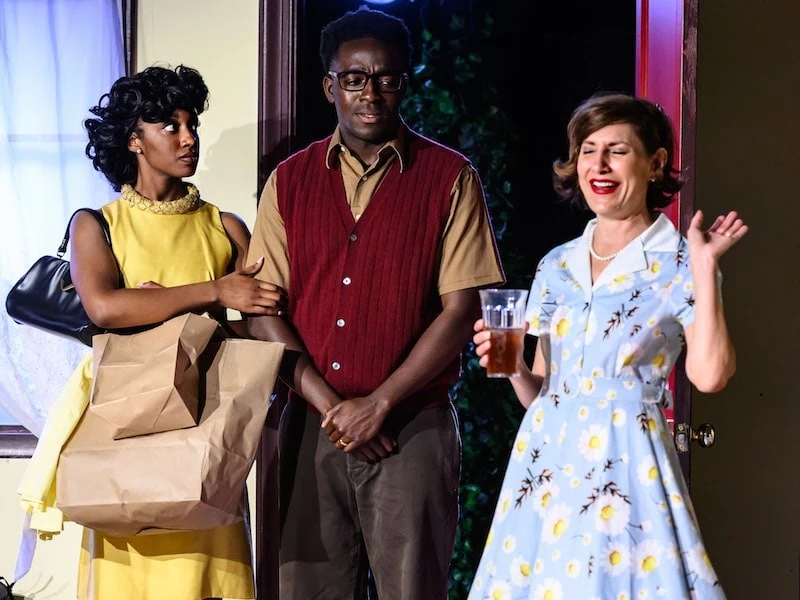By Whit Davis
This article was originally published in DC Theater Arts here.
Sometimes the story is not the play; it’s the acting.
The performers in the City of Fairfax Theatre Company’s production of Clybourne Park prove that sometimes local community theater talent is on par with the pros. It is clear that director Chaz D. Pando spent intentional time casting the production, working on table reads, and guiding the team of skilled actors through rehearsal. The brilliant performances by the actors confirm that.
Unfortunately, despite Clybourne Park being a Tony and Pulitzer Award-winning play, I found it problematic. The play’s attempt to tackle topics like racism, gentrification, capitalism, homophobia, and sexism feels like a giant undertaking that was undermined by playwright Bruce Norris’ paper-thin stereotypical portrayal of the play’s Black characters.
Clybourne Park is meant to be a nod to the Pulitzer Prize-winning play A Raisin in the Sun by acclaimed playwright Lorraine Hansberry. The story continues where A Raisin in the Sun left off as the Youngers, a Black family, are about to move to a middle-class white neighborhood in 1959. In Clybourne Park, the vantage point is from the white family they’re purchasing their new home from and the other white neighbors trying to convince the current owners that they should not sell to a Black family. But bubbling underneath is a secret that has the present family deep in grief.
In Act II of the play, set in 2009, the house is dilapidated, undergoing a renovation by a young white yuppie family following the trend of gentrification as they receive pushback on the modifications they are trying to make to their new home on the Southside of Chicago. An argument ensues bringing the tension between them to the surface.
The actors turn this material on its head by embodying the characters so that you believe you have traveled to 1959 and 2009. You feel you’re in the house with them as the dialogue unfolds, partly due to the 1959 set design by Roger Ray and costume design by Remeja Murray. The 2009 set feels less realistic, with bright blue, red, and yellow graffiti that spells out the word cop.
In the play’s first act, Ann Brodnax plays the wife Bev, and Kevin Dykstra her husband Russ. Together they give you the homespun feeling you’d expect from a TV show set in 1959. In the second act (each actor in Clybourne Park reappears as a new character for the second act set in 2009), Brodnax returns as the quirky lawyer Kathy and Dykstra as a construction worker named Dan, providing a much-needed dose of humor to the story. Eric Kennedy takes on the part of the priest Jim with a recognizable Southern accent. In the play’s second act, he plays Tom, a lawyer wanting to appear laidback. Later, Kennedy tackles the part of Kenneth in a jarring flashback scene at the end of the play. Karl, played by Rob Gorman, is a nosy, racist neighbor who believes he is doing the right thing for his community by fighting against a Black family moving into the neighborhood. In the second act, Gorman mirrors his character, but this time as a more modern younger version, Steve, suggesting that preconceptions and bigotry pass down from generation to generation.
The two Black characters in the play fall into recognizable tropes: the Black woman with an attitude and an aggressive Black man. A white playwright, Norris appears to have little insight into the inner lives of Black people. He writes from a place of assumption and stereotypes. Khanner Hancock plays the quick-witted characters of Francine and Lena. Tokunbo Adedeinde portrays the characters Albert and Kevin, Black men who go along to get along until they become angry. It’s disappointing to see Black characters written without any character development. Despite the play’s shortcomings, these actors make the most of their roles by giving the audience memorable performances.
Clybourne Park was praised as a nod to A Raisin in the Sun when it won the Pulitzer Prize in 2011. But in 2023, its flat portrayal of Black characters makes it feel like an attempt by the playwright to attach himself to a notable play and use it as a vehicle to garner interest in his work.
In the end, you should see this play because of the performances by a stellar cast. They are a great reminder of the value of local theater. The acting can be the whole story, and the performances in the City of Fairfax Theatre Company’s production are truly the best part of Clybourne Park.





No Comments